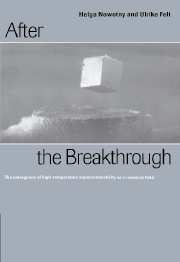Book contents
- Frontmatter
- Contents
- Acknowledgments
- 1 Introduction: the emergence of a new research field
- 2 The context of the discovery
- 3 Reconfiguring actors and knowledge: the organization of a new research field
- 4 Academic research, science policy, and the industrial connection: setting up national high-temperature superconductivity programs
- 5 Science and the media: newspapers and their “HTS story”
- 6 The innovation machinery of science: the case of HTS
- Appendix 1 Main events in the history of superconductivity before the discovery by Müller and Bednorz
- Appendix 2 Chronology of important events in high-temperature superconductivity in the early phase
- References
- Index
5 - Science and the media: newspapers and their “HTS story”
Published online by Cambridge University Press: 02 December 2009
- Frontmatter
- Contents
- Acknowledgments
- 1 Introduction: the emergence of a new research field
- 2 The context of the discovery
- 3 Reconfiguring actors and knowledge: the organization of a new research field
- 4 Academic research, science policy, and the industrial connection: setting up national high-temperature superconductivity programs
- 5 Science and the media: newspapers and their “HTS story”
- 6 The innovation machinery of science: the case of HTS
- Appendix 1 Main events in the history of superconductivity before the discovery by Müller and Bednorz
- Appendix 2 Chronology of important events in high-temperature superconductivity in the early phase
- References
- Index
Summary
One of the most striking features of the establishment of HTS as a research field is that – at least in the crucial first phase – negotiations expanded beyond the narrow realm of policy expertise into the public arena. The exceptional breakthrough was greeted by the media with great enthusiasm and was judged as newsworthy for a considerable time. Though not actively participating, the public came to play an important role as enthusiastic supporters or critical observers of the field's evolution and as allies in developing an extensive rhetoric about the significance of the field's potential technological applications.
A trend toward increasing the degree of public staging of science and technology issues has become more and more visible in the course of the second half of the 20th century. Dorothy Nelkin argues that this is closely linked to the fact that the societies we live in are increasingly shaped by science and technology. Members of these societies are thus:
continually confronted with choices that require some understanding of scientific evidence: whether to allow the construction of a nuclear power plant, or a toxic waste disposal dump … The press should provide the information and the understanding that is necessary if people are to think critically about decisions affecting their lives
(Nelkin, 1987: 2).Indeed, press reports described the intense excitement gripping scientists and science policy-makers alike in these first months following the breakthrough in HTS, and they elaborated spectacular scenarios of future applications. The media eagerly seized on the notion of competition for technological and commercial advantage, playing up the potentially crucial role of the new materials in the development of an as yet unimaginable technology.
- Type
- Chapter
- Information
- After the BreakthroughThe Emergence of High-Temperature Superconductivity as a Research Field, pp. 127 - 159Publisher: Cambridge University PressPrint publication year: 1997

